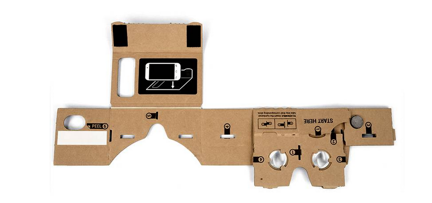Clocking in at more than two and a half hours, the Google I/O keynote yesterday was a veritable marathon of updates, announcements and releases.
Android—with Android “L,” Android Auto, Android Wear, Android TV, Android for Work and the Android One software platform—won the day, but Google also managed to slip in plugs for Chromecast, Chromebook, Google Drive, Google Compute Engine, Google Play Games, and Google Fit.
(Related: Google brings Android “L” to TV, cars, wearables and more in I/O keynote)
Yet despite running through what seemed like their entire product canon, even more telling is what Google didn’t talk about. Not directly, anyway.
At the very end of the keynote, amid giveaways of LG G2 and Samsung Galaxy Gear smartwatches, keynote emcee and Google SVP of Android, Chrome and Google Apps Sundar Pichai wore a childish smirk as he announced that every developer at Google I/O would walk out with a free piece of cardboard.
Pichai quickly moved on. The keynote ended. Confusion abounded. Developers started picking up the precarious cardboard giveaways and opened them up. A Cardboard developer site goes viral online. What came off as a last-minute joke turned out to be a do-it-yourself viewer and open software toolkit to turn your smartphone into a cheap virtual reality headset.

Cardboard: Google’s do-it-yourself virtual reality headset
On top of trotting out another draw for Android phones and scoring major open-source and ingenuity points, Cardboard also serves as a not-so-subtle neener-neener to the Facebooks and Sonys of the world investing heavily in virtual reality technology.
Pichai’s boyish grin while holding up a piece of cardboard makes a lot more sense now. The lowest of the low-tech move is a viral smash.
However, Google’s clever little victory in virtual reality also draws attention to a stark absence, raising the question: Why was there not a word about the tech giant’s long-awaited augmented reality offering?
What about Google Glass?
Google has poured vast amounts of time, resources and manpower into its augmented reality glasses, which will reportedly be widely available late this year. The device’s complete absence at Google’s marquee developer event this close to an expected release is a telling omission, considering how strongly Google is pushing Google Glass to developers through the Glass Explorer Program and Glassware tools.
(Related: A view of Glass from developers’ eyes)
No one would pretend Google’s Glass rollout has been smooth. People walking around with computers on their face have met with a cultural reaction defined by awkward stares, Glass bans in public places, and widespread anti-“Glasshole” sentiment. Strapping designer frames on the AR glasses haven’t softened those opinions much.
Glass wasn’t completely invisible at I/O; there were apparently some demos and breakout sessions on the show floor. But Google’s few announcements about it were made several days in advance of the Android- and Chrome-dominated conference.
All that said, Google Glass isn’t going anywhere. The wide release is coming whether consumers like it or not, be it this fall or soon thereafter. But as the sad child sitting in the corner at Google I/O, there’s an unsettling aura surrounding the product that has come to define augmented reality over the past few years. Google’s wavering confidence in the product is a dangerous road that leads to warehouses chock full of unused hardware. Just ask Microsoft about their piles and piles of unsold Surface tablets.
If Glass was Google’s sad child sitting sullen in the corner at I/O, Google+ was the bastard child that wasn’t even invited.
This absence wasn’t a surprise, but it’s still worth noting. Google’s social network-turned universal platform ended its forced integration into other Google products, namely the dreaded YouTube comment login, back in April along, with the departure of Google+ head Vic Gundotra. Hangouts and Photos were moved under the Android banner.
I/O, where G+ has been a staple in years past, was a prime opportunity for Google to announce a new direction or strategy for the aimless platform, but that time came and went. While it may never be as dramatic as taking Google+ out behind the shed with a shotgun, it looks as if there’s no plan but to keep on scrapping the G+ for parts.
Watch the full keynote here.






